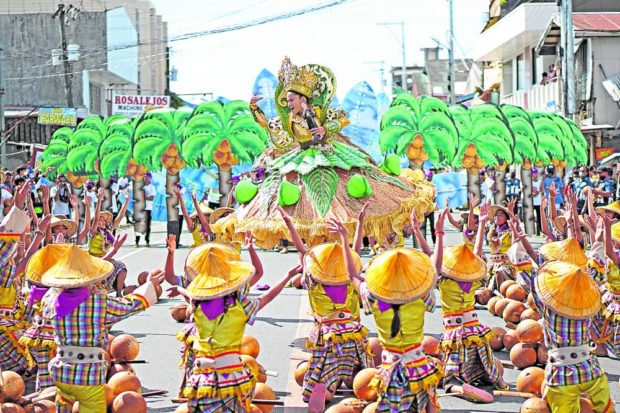‘Bonok-Bonok’: A dance for Surigao’s recovery

PRAYER | A contingent from Surigao City performs the “bonok-bonok” in the street dancing showdown last week to honor St. Nicolas de Tolentino. Traditionally an indigenous ritual in praying for rain, the dance is also performed by locals to plead for recovery from the devastation from Typhoon “Odette” (international name: Rai) and the COVID-19 pandemic. (Photo by ERWIN MASCARIÑAS / Inquirer Mindanao)
SURIGAO CITY, Surigao del Norte, Philippines — Eight months after the devastation wrought by Typhoon Odette (international name: Rai), officials here are confident about the city’s renewed tourism takeoff.
Over the weekend, the city’s streets erupted in colors and pageantry at the culmination of the Bonok-Bonok Festival, an annual celebration in honor of St. Nicolas de Tolentino, Surigao’s patron.
Thousands of visitors trooped into the city for the grand street dancing show after a two-year absence due to the COVID-19 pandemic, filling its tourist destinations.
“After two years of restrictions due to the pandemic, and after the devastation of Supertyphoon Odette, we are happy that Bonok-Bonok is back. It is one of the biggest and grandest festivals in the Caraga region,” said Nelia Arina, the Department of Tourism regional director.
Derailed
According to Arina, the festival’s restaging only shows that Surigaonons have moved forward.
Article continues after this advertisement“In the past, our records suggested how much this festival had been attracting tourists to Surigao City. This will signal next year and in the years to come for tourists to return,” she said, noting that tourism will be a major driver of recovery for the city.
Article continues after this advertisementDuring the pandemic when there was a big slack in tourist arrivals, the city government and local businessmen invested heavily in promotions and infrastructure in anticipation of the reopening of the economy under the “new normal.” But this was derailed by Odette last December.
Roselyn Armida Merlin, the city’s supervising tourism operations officer, said this year’s festival theme, “Sadjaw sa Pagbangon nan Surigao,” means to dance for the recovery of Surigao City from the destruction of Odette.
Mayor Paul Dumlao said the festival started in 1984, coincidentally right after Typhoon “Nitang” devastated the city. It was first held as a thanksgiving after the city gradually got back on its feet then.“‘Bonok’ means heavy downpour. The pouring of rain, for us, signifies a blessing from the sky. ‘Bonok-bonok,’ which repeats the word, means continuous pouring of blessings,” Merlin said.
Local historians traced the festivity back to the tradition of early indigenous settlers, the Mamanwa and Manobo, who used to dance in a ritual wishing for rain.
Merlin said September, back then, used to be a dry month. “The climate and the dry and wet season [pattern] might have changed but the tradition remained,” she said.
RELATED STORIES
Tourism board: Mindanao safe for tourists
New tourism experience through ‘Colors of Mindanao’